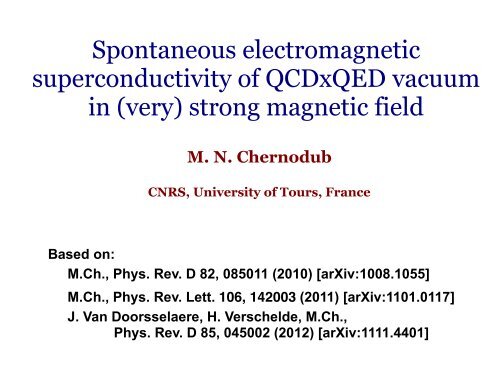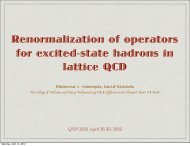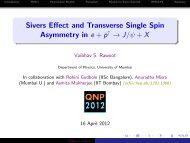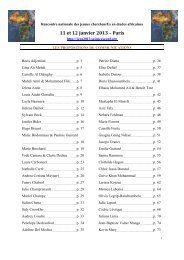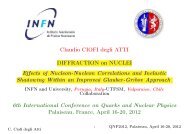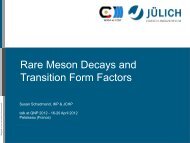Maxim Chernodub - QNP2012
Maxim Chernodub - QNP2012
Maxim Chernodub - QNP2012
Create successful ePaper yourself
Turn your PDF publications into a flip-book with our unique Google optimized e-Paper software.
Spontaneous electromagnetic<br />
superconductivity of QCDxQED vacuum<br />
in (very) strong magnetic field<br />
M. N. <strong>Chernodub</strong><br />
CNRS, University of Tours, France<br />
Based on:<br />
M.Ch., Phys. Rev. D 82, 085011 (2010) [arXiv:1008.1055]<br />
M.Ch., Phys. Rev. Lett. 106, 142003 (2011) [arXiv:1101.0117]<br />
J. Van Doorsselaere, H. Verschelde, M.Ch.,<br />
Phys. Rev. D 85, 045002 (2012) [arXiv:1111.4401]
What is «very strong» field? Typical values:<br />
●<br />
Thinking — human brain: 10 -12 Tesla<br />
● Earth's magnetic field: 10<br />
-5<br />
Tesla<br />
● Refrigerator magnet: 10<br />
-3<br />
Tesla<br />
● Loudspeaker magnet: 1 Tesla<br />
IgNobel 2000 by<br />
A.Geim (got Nobel<br />
2010 for graphene)<br />
● Levitating frogs: 10 Tesla<br />
● Strongest field in Lab: 10<br />
3<br />
Tesla<br />
Destructive explosion<br />
● Typical neutron star: 10<br />
6<br />
Tesla<br />
● Magnetar: 10<br />
9<br />
Tesla<br />
● Heavy-ion collisions: 10<br />
15...16<br />
Tesla<br />
● Early Universe: even (much) higher
Superconductivity<br />
Discovered by Kamerlingh Onnes at the Leiden University<br />
100 years ago, at 4:00 p.m. April 8, 1911 (Saturday).<br />
Type I<br />
Type II<br />
I. Any superconductor has zero electrical DC resistance<br />
II. Any superconductor is an enemy of the magnetic field:<br />
1) weak magnetic fields are expelled by<br />
all superconductors (the Meissner effect)<br />
2) strong enough magnetic field always kills superconductivity
Our claim:<br />
In a background of strong enough magnetic field<br />
the vacuum becomes a superconductor.<br />
The superconductivity emerges in empty space.<br />
Literally, “nothing becomes a superconductor”.<br />
Some features of the superconducting state of vacuum:<br />
1. spontaneously emerges above the critical magnetic field<br />
or<br />
B c<br />
≃ 10 16 Tesla = 10 20 Gauss<br />
eB c<br />
≃ m ρ<br />
≃ 31 m π<br />
≃ 0.6 GeV<br />
2 2 2<br />
2. conventional Meissner effect does not exist<br />
can be reached<br />
in experiments!<br />
The claim seemingly contradicts textbooks which state that:<br />
1. Superconductor is a material (= a form of matter, not an empty space)<br />
2. Weak magnetic fields are suppressed by superconductivity<br />
3. Strong magnetic fields destroy superconductivity
1+4 approaches to the problem:<br />
0. General arguments; (this talk)<br />
1. Effective bosonic model for electrodynamics of ρ mesons<br />
based on vector meson dominance<br />
[M.Ch., PRD 2010; arXiv:1008.1055] (this talk)<br />
2. Effective fermionic model (the Nambu-Jona-Lasinio model)<br />
[M.Ch., PRL 2011; arXiv:1101.0117] (this talk)<br />
3. Nonperturbative effective models based on gauge/gravity<br />
duality (utilizing AdS/CFT duality)<br />
[Callebaut, Dudal, Verschelde (Gent U., Belgium), arXiv:1105.2217];<br />
[Erdmenger, Kerner, Strydom (Munich, Germany), arXiv:1106.4551]<br />
(this talk)<br />
5. First-principle numerical simulation of vacuum<br />
[ITEP Lattice Group, Moscow, Russia, arXiv:1104.3767] (this talk)
QCDxQED vacuum in strong magnetic field<br />
Ingredients needed for possible superconductivity:<br />
A. Presence of electric charges?<br />
Yes, we have them: there are virtual particles<br />
which may potentially become “real” (= pop up from the vacuum)<br />
and make the vacuum (super)conducting.<br />
B. Reduction to 1+1 dimensions?<br />
Yes, we have this phenomenon: in a very strong magnetic field<br />
the dynamics of electrically charged particles (quarks, in our case)<br />
becomes effectively one-dimensional, because the particles tend<br />
to move along the magnetic field only.<br />
C. Attractive interaction between the like-charged particles?<br />
Yes, we have it: the gluons provide attractive interaction between<br />
the quarks and antiquarks (q u<br />
=+2 e/3 and q d<br />
=+e/3)
Charged particles in magnetic field background<br />
- Energy of a relativistic particle in the external magnetic field B ext<br />
:<br />
momentum along<br />
the magnetic field axis<br />
nonnegative integer number<br />
projection of spin on<br />
the magnetic field axis<br />
(the external magnetic field is directed along the z-axis)<br />
- Masses of ρ mesons (s=1) and pions (s=0) in magnetic field<br />
becomes heavier<br />
becomes lighter<br />
- ρ meson decay: (always via π ± [PDG])<br />
- Masses of ρ mesons and pions (at vanishing magnetic field):
Condensation of ρ mesons<br />
The ρ ± mesons become massless and condense<br />
at the critical value of the external magnetic field<br />
masses in the external magnetic field<br />
Kinematical impossibility<br />
of dominant decay modes<br />
The pion becomes heavier while<br />
the rho meson becomes lighter<br />
- The decay<br />
stops at certain value<br />
of the magnetic field<br />
- A similar statement is true for
Electrodynamics of ρ mesons<br />
(one can also consider the Nambu-Jona-Lasinio model and get similar results)<br />
- Lagrangian (based on vector dominance models):<br />
Nonminimal<br />
coupling<br />
leads to g=2<br />
- Tensor quantities<br />
- Covariant derivative<br />
- Kawarabayashi-Suzuki-<br />
Riadzuddin-Fayyazuddin relation<br />
- Gauge invariance<br />
[D. Djukanovic, M. R. Schindler, J. Gegelia, S. Scherer, PRL (2005)]
Homogeneous approximation<br />
- The condensate of the rho mesons:<br />
- The energy of the condensed state:<br />
(basically, a Ginzburg-Landau potential for an s-wave superconductivity!)<br />
- The amplitude<br />
of the condensate:<br />
(the same picture in NJL)<br />
Second order (quantum) phase<br />
transition, critical exponent = 1/2
Structure of the condensates<br />
In terms of quarks, the state<br />
implies<br />
(one gets the same results in<br />
the Nambu-Jona-Lasinio model)<br />
Depend on transverse coordinates only<br />
Abelian gauge symmetry<br />
Rotations around B-axis<br />
- The condensate “locks” rotations around field axis and gauge transformations:
Basic features of ρ meson condensation<br />
- The condensate of the ρ mesons appears in a form of<br />
an inhomogeneous state, analogous to the Abrikosov lattice<br />
in the mixed state of type-II superconductors.<br />
A similar state, the vortex state of W bosons, may appear in Electroweak<br />
model in the strong external magnetic field [Ambjorn, Olesen (1989)]<br />
- The condensate forms a lattice, which is made of the new type of<br />
topological defects, the ρ vortices.<br />
- The emergence of the condensate of the charged ρ mesons<br />
induces spontaneous condensation of the neutral ρ mesons.<br />
- The condensate of charged ρ mesons implies superconductivity.<br />
- The condensate of neutral ρ mesons implies superfluidity.<br />
- Unusual optical properties of the superconducting state:<br />
It is a metamaterial (“perfect lens” optical phenomenon) with<br />
negative electrical permittivity (ε), negative magnetic permeability (µ),<br />
negative index of refraction (n) [Smolyaninov, PRL 107, 253903 (2011)].
Solution for condensates of ρ mesons<br />
Superconducting condensate<br />
(charged rho mesons)<br />
B = 1.01 B c<br />
Superfluid condensate<br />
(neutral rho mesons)<br />
(similar results in NJL)<br />
New objects, topological vortices, made of the rho-condensates<br />
The phases of the rho-meson<br />
fields wind around vortex<br />
centers, at which the<br />
condensates vanish.
Topological structure of the ρ mesons condensates
Anisotropic superconductivity<br />
(via an analogue of the London equations)<br />
- Apply a weak electric field E to an ordinary superconductor<br />
- Then one gets accelerating electric current along the electric field:<br />
- In the QCDxQED vacuum, we get<br />
an accelerating electric current<br />
along the magnetic field B:<br />
[London equation]<br />
( )<br />
Written for an electric current<br />
averaged over one elementary<br />
(unit) rho-vortex cell<br />
(similar results in NJL)
Experimental verification?<br />
Over-critical magnetic fields (of the strength B ~ 2 B c )<br />
may be generated in ultraperiferal heavy-ion collisions<br />
(duration is short, however – clarifications are needed)<br />
W. T. Deng and X. G. Huang, arXiv:1201.5108 [nucl-th]<br />
A bit of dreams (in a verification stage):<br />
Signatures of the superconducting state of the vacuum could<br />
possibly be found in ultra-periferal heavy-ion collisions at LHC.<br />
[ultra-periferal: cold vacuum is exposed to strong magnetic field]
Conclusions<br />
●<br />
In a sufficiently strong magnetic field condensates with<br />
ρ meson quantum numbers are formed spontaneously via<br />
a second order phase transition with the critical exponent 1/2.<br />
●<br />
The vacuum (= no matter present, = empty space, = nothing)<br />
becomes electromagnetically superconducting.<br />
● The superfluidity of the neutral ρ 0 mesons emerges as well.<br />
●<br />
The superconductivity is anisotropic: the vacuum behaves as<br />
a superconductor only along the axis of the magnetic field.<br />
● New type of tological defects,''ρ vortices'', emerge.<br />
● The ρ vortices form Abrikosov-type lattice in transverse directions.<br />
●<br />
The Meissner effect is absent.
Backup slides
Anisotropic superconductivity<br />
(Lorentz-covariant form of the London equations)<br />
We are working in the vacuum, thus the transport equations<br />
may be rewritten in a Lorentz-covariant form:<br />
Electric current<br />
averaged over<br />
one elementary<br />
rho-vortex cell<br />
A scalar function of Lorentz invariants.<br />
In this particular model:<br />
Lorentz invariants:<br />
(slightly different form of κ function in NJL)
Key players: ρ mesons and vacuum<br />
- ρ mesons:<br />
• electrically charged (q= ±e) and neutral (q=0) particles<br />
• spin: s=1, vector particles<br />
• quark contents: ρ + =ud, ρ – =du, ρ 0 =(uu-dd)/2 1/2<br />
• mass: m ρ =775.5 MeV (approximately 1550 electron masses)<br />
• lifetime: τ ρ =1.35 fm/c (very short: size of the ρ meson is 0.5 fm)<br />
- vacuum: QED+QCD, zero tempertature and density
Numerical simulations of vacuum<br />
in the magnetic field background<br />
V.Braguta, P. Buividovich, M. Polikarpov, M.Ch., arXiv:1104.3767<br />
Numerical simulation:<br />
Theory:<br />
condensate<br />
magnetic field<br />
[qualitatively realistic vacuum, quantitative results may receive corrections (20%-50% typically)]
Conventional BCS superconductivity<br />
1) The Cooper pair is<br />
the relevant degree<br />
of freedom!<br />
2) The electrons are<br />
bounded into the<br />
Cooper pairs by<br />
the (attractive)<br />
phonon exchange.<br />
Three basic ingredients:
Real vacuum, no magnetic field<br />
1) Boiling soup of everything.<br />
Virtual particles and antiparticles<br />
(electrons, positrons, photons,<br />
gluons, quarks, antiquarks …)<br />
are created and annihilated<br />
every moment.<br />
2) Net electric charge is zero.<br />
An insulator, obviously.<br />
3) We are interested in “strongly<br />
interacting” sector of the theory:<br />
a) quarks and antiquarks,<br />
i) u quark has electric charge q u<br />
=+2 e/3<br />
ii) d quark has electric charge q d<br />
=- e/3<br />
b) gluons (an analogue of photons, no electric charge) “glue”<br />
quarks into bounds states, “hadrons” (neutrons, protons, etc).
Strong magnetic field, picture


